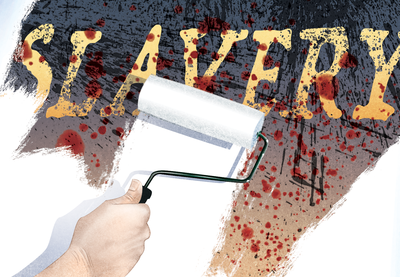Introduction
In the Teaching Tolerance magazine feature “Lies My Bookshelf Told Me: Slavery in Children’s Literature,” Dr. Ebony Elizabeth Thomas advises educators to “present as much of the truth as the child can handle.” Following this recommendation requires care, and it requires finding the right source materials to tell that truth.
This toolkit provides a brief overview of the Teaching Hard History Text Library, a resource packed with primary and secondary sources. You can use these sources to teach about American slavery in an honest and age-appropriate way while lifting up the voices and lives of enslaved people. The library offers nearly a hundred primary sources, from photographs to etchings to transcriptions of speeches, advertisements, letters, narratives and more. The collection also includes secondary sources—texts about slavery created after the fact, often based on primary source material.
You can search the materials in the Teaching Hard History Text Library in a number of ways, including by grade level (K–2, 3–5, 6–8 and 9–12) and text type (e.g., literature, visual and informational). Each document includes text-dependent questions that educators can use to guide discussion. These questions offer guidance to help students understand the texts themselves and tie these texts to their broader learning about enslavement.
Essential Question
What can younger students learn about enslavement from class readings?
Secondary sources can introduce important figures and key concepts about enslavement.
In the Teaching Hard History Text Library, secondary sources for younger students tend to fall into two categories: short biographies or short stories. These texts introduce students to historic figures and significant concepts that may be new to them.
Here are just a few examples:
- In “Mum Bett’s Freedom Tale,” students learn the remarkable story of Elizabeth Freeman, an enslaved woman who filed a lawsuit for her freedom and, winning, paved the way for abolition in Massachusetts. The story also introduces young readers to the idea of domestic enslavement, and it offers an example of one of the many ways enslaved people exercised their agency to resist dehumanization.
- The narrative “Hercules’ Daughter” offers a lightly fictionalized account of the real-life Delia, daughter of a chef who escaped enslavement by George Washington. Even students in the early grades can use this story to start a conversation about freedom, liberty and the tension between American ideals and antebellum reality.
- In “Is Reading Bad?” readers hear directly from a fictional, enslaved protagonist who must learn to read in secret. The story allows for connection across time and builds awareness of the experiences of enslaved people, including enslaved children, but it also opens the possibility for conversations about the policing of literacy and the brutality of enslavement.
Primary sources can provide valuable context, re-center the lives of enslaved people and encourage critical thinking.
Because most primary source documents were created during the 19th century or earlier, these texts are often leveled for grades 6 and above. However, with proper scaffolding (including secondary texts), they may also be of use with younger students. Here are just two examples:
- “Lives of the Enslaved in Their Own Words” does some of this contextualizing for educators. Although the extended introduction and contextual information technically make this a secondary source, this text includes long quotations from the writing of enslaved people. One particular benefit of this text is that it reinforces the idea that freedom was an exceptional fate, as noted in “Lies My Bookshelf Told Me.” Pairing better-known enslaved writers like Frederick Douglass and Harriet Jacobs with letters by Abream Scriven and Vilet Lester, the text encourages students to consider how rarely we hear “ordinary” stories of enslavement—and how heartbreaking those stories can be.
- Those “ordinary” stories also come to the fore in the “lost friends advertisements” in our text library: “Advertisement by Clarissa Reed,” “Letter From Fanny Ward” and “S.L. Jones Searching for Relatives.” These texts, written during Reconstruction and published in local newspapers across the South, were attempts by formerly enslaved people to find loved ones who had been sold away during enslavement. They not only offer insight into the brutality of this practice, but they also invite students to consider the ways slavery continued to cause harm long after abolition.
As “Lies My Bookshelf Told Me” makes clear, it can be challenging to find texts that engage the history of American slavery with honesty and empathy. The Teaching Hard History Text Library is a good place to start.
Additional Resources
Teaching Hard History | A framework for teaching the history of American slavery
Teaching Hard History | A Teaching Tolerance magazine feature about how educators are engaging this subject with students
Toolkit for Teaching Hard History |A sample unit using primary source documents to teach about slavery
We Are Our Ancestors’ Wildest Dreams | A Teaching Tolerance magazine roundtable discussion with black educators who’ve taken the challenges of Teaching Hard History
Teaching Hard History Podcast | For the purposes of this toolkit, we recommend episode four (“Dealing With Things as They Are: Creating a Classroom Environment”) and episode seven (“Diverse Experience of the Enslaved”).
African Americans in Slavery | A photo collection from the National Humanities Center, including primary sources appropriate for younger students
Images of African-American Slavery and Freedom | A collection of visual primary source documents from the Library of Congress

